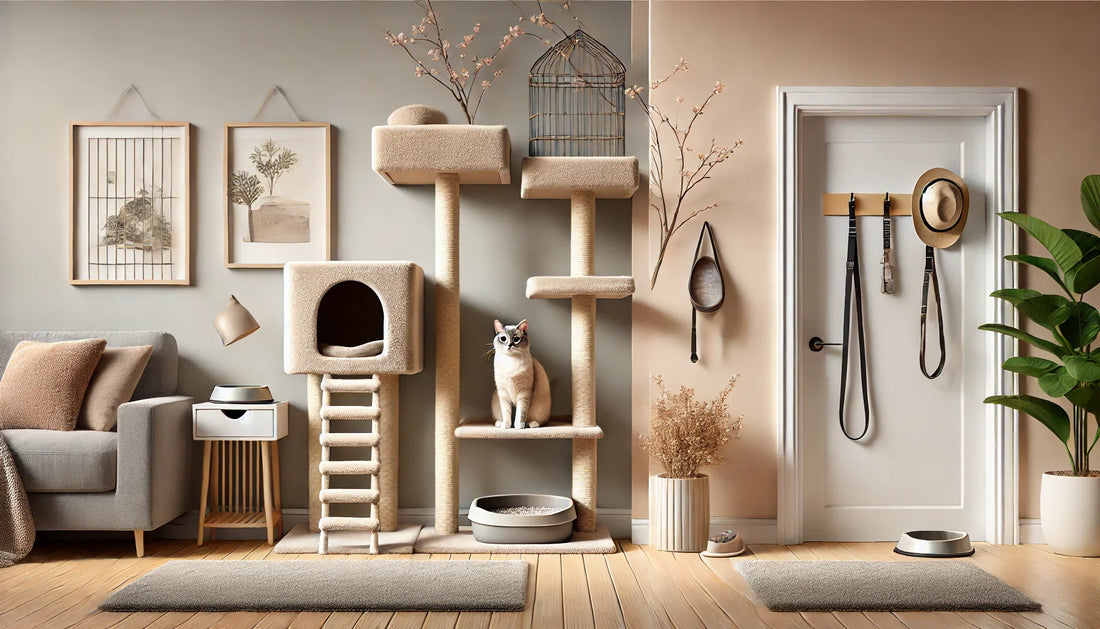
The Essential Differences Between Raising Cats and Dogs — Lords of Space, Companions of Time
Share
Preface
Animals are not our pastime but our charge. Cats and dogs both belong under the word “companion,” yet they keep different calendars of need. What follows is a sober, usable blueprint—less sentiment, more stewardship.
1) Daily Rhythm — Space-first vs. Time-first
-
Cats: Thrive on territory stability and predictable rituals; solitude is tolerable if the environment is rich and calm.
-
Dogs: Thrive on shared time—regular walks, training, and play. Without that cadence, frustration and misbehavior rise.
2) Elimination & Outings
-
Cats: Indoor life with a sand-like, unscented litter box (right size, depth, placement, and hygiene) is half the battle. Carrier training matters for vet trips.
-
Dogs: Leash walks and outdoor elimination are baseline—rain, cold, or heat included. House training pairs well with crate/pen management and consistent timing cues.
3) Training Philosophy
-
Cats: Lead with environmental design (resources placed to invite good choices) and targeted rewards. Coercion erodes trust; options increase compliance.
-
Dogs: Lead with consistent, reward-based training. Keep commands simple, sessions short and frequent, and timing precise.
4) Socialization & Visitors
-
Cats: Introduce new people, sounds, and spaces slowly. Provide elevated retreats and hiding places; choice is security.
-
Dogs: Plan broad, positive exposures to people, places, and noises. Use distance and simple behaviors (sit, eye contact) to dial down arousal.
5) Play & Energy Expenditure
-
Cats: Simulate the predation sequence (stalk → pounce → capture → eat → groom → sleep) with wand toys and food puzzles. Short, intense sessions beat aimless play.
-
Dogs: Combine movement + rules—structured walks, nose work, fetch with cues, and basic obedience. Exercise alone is not training; the union matters.
6) Home Safety & Furnishings
-
Cats: Vertical routes (shelves, trees), scratchers, secure screens; avoid toxic plants and heavy fragrances.
-
Dogs: Manage cables and trash, add non-slip rugs, pick the right harness, and gate risky zones (kitchen, stairs) as needed.
7) Health Priorities
-
Cats: Weight control, urinary health, dental care, and stress reduction. Monitor litter box patterns for early warnings.
-
Dogs: Weight control, joint care, dental care, and parasite prevention; breed-specific screening and activity needs drive the schedule.
8) Cost & Time Commitments
-
Cats: Lower routine time per day; steady costs for food, litter, and periodic vet care. Environmental upgrades (trees, puzzles) pay long dividends.
-
Dogs: Higher daily time (walks, training); recurring costs for daycare/walkers if schedules are tight; more frequent grooming for some breeds.
9) Travel & Housing Constraints
-
Cats: Often easier in apartments if territory is enriched; travel requires deliberate acclimation to carriers and new rooms.
-
Dogs: Landlord rules, neighbors, and access to outdoor space matter; travel plans must account for boarding or pet-friendly stays.
10) Communication Signals
-
Cats: Subtle—ears, tail tip, pupil size, grooming/withholding. Respect “no” signs early to prevent escalation.
-
Dogs: Clearer—ears, tail carriage, panting, tongue flicks, weight shift. Teach calm alternatives and reward them.
11) Multi-Pet Households
-
Cats: Resources must be duplicated and dispersed (litter, food, water, rest spots). Side-by-side is often perceived as “one.”
-
Dogs: Structure reduces conflict—clear routines, managed greetings, individual training time, and feeding separation as needed.
12) When Things Go Wrong (Triage)
-
Cats: Rule out medical causes (pain, urinary issues) first; then adjust environment and routines before behavior meds are considered.
-
Dogs: Check for pain or under-exercise; tighten routine, increase mental work, and reinforce calm. Seek a qualified trainer early.
Quick Decision Matrix (printable)
-
Limited daily hours? → Cat (with rich environment).
-
Crave outdoor routine and teamwork? → Dog.
-
Noise-sensitive building? → Cat likely simpler.
-
Allergic to litter dust or fragrances? → Dog may fit better.
-
Frequent travel? → Cat with sitter, or dog with reliable boarding/daycare plan.
Conclusion
Choose with reverence for the creature’s design. The cat governs space; the dog shares time. Honor that axis and peace settles over the home.
CTA
Before adopting, write a one-week schedule for feeding, cleaning/walks, training/play, and vet logistics. If the draft feels tight, simplify now—mercy for the animal begins on paper.
